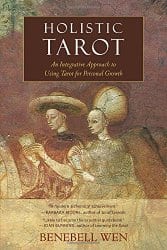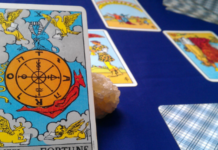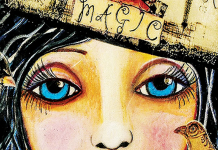
 Holistic Tarot: An Integrative Approach to Using Tarot for Personal Growth, by Benebell Wen
Holistic Tarot: An Integrative Approach to Using Tarot for Personal Growth, by Benebell Wen
North Atlantic Books, 158394835X, 896 pp (incl. notes, appendices, and index), 2015
Holistic Tarot is useful as a tool for personal growth and study, with fresh ideas for tarot enthusiasts from a variety of backgrounds. Tarot practitioners can glean inspiration and find structure for instruction, spiritual and magical use, yet at the same time, an argument is made that much of tarot’s usefulness comes not from mysticism but from analytical psychology.
Including notes, appendices and index, Holistic Tarot is nearly 900 pages, and is chock-full of tables, spreads, and writing that is practical, comprehensive, and transformative. The book itself is more than a vast instruction manual for tarot practitioners from novice to skilled levels, Benebell Wen also encourages its use as a volume for teaching tarot. It includes information for numerous disciplines, giving a nod to the Tree of Life, astrology, numerology and the author’s roots in eastern thought, with the I Ching, a Ba Gua spread, and a sprinkling of the concept of qi throughout.
Holistic Tarot’s main thrust is one of tarot as an analytical tool. “(P)ersonal empowerment” and “rational-based applications”1 are emphasized. Through the holistic application of tarot and the intimate meaning it inspires, it is regarded as a psychological device. Wen illustrates her points with journal prompts and case studies from her own experience. Her “approach to tarot is not predictive. It is analytic.”2 Against solely telling fortunes, and instead using cards to determine patterns and potential outcomes, Wen suggests that the cards are a science of the mind.3 Readers project and evaluate as they use tarot. Depth psychologists, dream interpreters, and others who relish the world of symbols and self-cure will appreciate Holistic Tarot for its extensive interpretative material.
This book addresses criticism of tarot readers and psychics and supports a framework for those who practice tarot and those who seek the cards for answers. She states, in her chapter on the professional practice of tarot, that a bad reputation for tarot practitioners comes from their advertising that they predict the future.4 Wen lays out the foundation for her application of tarot early in the text: “We do not have pre-determined fates; rather, we have dispositions. From there we walk a garden of forking paths, and the forks we chose are what determine our future.”5
On the garden of forking paths are many means of reading and using tarot. Wen dedicates ample space to a myriad of spreads a tarot practitioner can employ to read. She also writes in depth on signifiers, and offers many reasons to include and choose a signifier in tarot. The methods used to select a signifier or significator (typically a court card to represent a person receiving a reading) seem boundless. But the book does not intimidate. Throughout her text, Wen initially offers traditional constructs, and from there a reader may choose to further develop or experiment with basic guidelines. Wen describes signifier cards as “imperative in grounding a reading” — anchors that represent the energy of a person being read.6
It should prove as a beneficial book for anyone studying the science of tarot, as well as those who question its rational use. Holistic Tarot contains numerous case studies that support Wen’s argument of tarot as rational science. When approaching the court cards, for example, she compares readings for men and for women, using the same set of three cards in a few examples. When the Queen of Swords was drawn for a case study for a young man, Wen wrote “a female court card appearing in his spread more likely represents an actual woman in his life than a facet of himself, though do not immediately rule out the figurative interpretation either.”7
Holistic Tarot broaches creative contexts for the use of tarot, from a large variety of spreads, prompts for journalling, and different ways of approaching each card. Court cards are helpfully interpreted as 16 archetypal voices, according to Avia Venefica. The court card section is complete with charts, examples, literal and figurative approaches, how the appearance of more than one court card works in a reading, and more. Holistic Tarot consistently moves beyond familiar designations for cards and spreads, while recognizing earlier meanings, making all information clear and at the ready for readers.
A recent court card I’m learning to identify with is the Page of Swords. Wen explains that it can be helpful to choose a Page for people of a young age. With such a card, my colleagues will likely be other Pages as well as Knights. Wen illustrates how the Page of Swords faces left, identifying it with the moon, yin energy, the occult, and more, and the author discusses the cultural implications of the left-path in Native American and western mysticism traditions.
Wen has done extensive work to foster polished and caring tarot users. Her book argues for self-study along with the honouring of tradition. It features a chapter about working professionally as a practitioner, highlighting the need for a safe space for seekers (clients) who cross a reader’s path. Wen, herself a lawyer who had stepped away from tarot for some time, includes the legalities and practical side of tarot business. She includes templates for recording readings, too. Though this requires discipline, I’ve found as a tea leaf reader it is best practice to document one’s readings. I have been able to gauge the efficacy and limits of my skills, and in doing so, have nourished my intuition, and Wen’s templates provide similar opportunity.
Wen writes of a desire for individuals to shape their relationships with the cards and provides many ideas on how to compose what she calls intermediate ruminations. “There is a strong interrelationship between the intuitive and the creative, so creative writings around the tarot ruminations are highly encouraged.”8 With multiple resources for spreads, ideas on how to shuffle and how to approach the profession of tarot reading, the book is inspirational, and includes generous information and imagery for Rider-Waite-Smith deck users.
The premise of the book may best be expressed in the imperative that tarot practitioners exercise their own judgement. “Consider your own subjective points of view”9 and ask, as seekers, why particular archetypal symbols have appeared in each reading, “and what spiritual or intuitive message is being conveyed.”10 The book seems at once respectful and knowledgeable of the cards while it encourages rational work and self-awareness.
Holistic Tarot is a massive resource for almost any reading style you can imagine, with ideas for tarot interpretation that provides a means for understanding each card and various spreads.








